

Silicone sensors give robot fingers the human touch. Robot arms that can feel as well as grip are on the way, but developing a bionic nervous system is expensive and complicated.
Is there an easier, cheaper way to bring enhanced dexterity to an android's digits? One Hungarian start-up says there is. OptoForce is the Budapest-based firm behind a new kind of sensor which uses a blend of silicone and infrared light to dynamically measure the changing force exerted on a robot's fingers. The results are good enough for a 3-axis claw fitted with the sensors to keep a secure grip while an empty cup is gradually filled with liquid. When pressure is applied to the surface of one of the sensors, their pliable half-sphere shape is slightly deformed, an action which instantly changes this distribution of infrared light from the LED inside. The economic impact of the robotic revolution. Whilst the word ‘robot’ generally conjures up visions of humanoids with superior intelligence, this science fiction image tends to forget the other type of robots: machines that carry out complicated motions and tasks, such as automated software processes1, industrial robots, unmanned vehicles (driverless cars, drones) or even prosthetics.
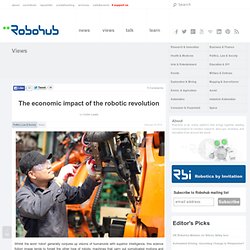
“Intelligent” robots threaten millions of jobs warns Ed Balls. A new generation of robots such as Google’s driverless car and the Amazon delivery drone will put the jobs of millions of white collar experts in jeopardy.
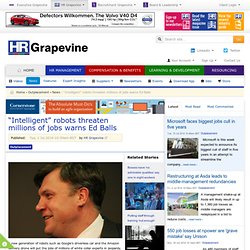
That’s according to shadow chancellor, Ed Balls who has warned that Britain needs a “major expansion” of university technical colleges to train highly skilled people in science, maths and engineering. Balls said: “We have seen profound technological change which is not just substituting for unskilled labour, but replacing traditional middle-income jobs too.” Office staff, factory workers and drivers risk losing their jobs in the future due to the advances in “intelligent” machines, he continued: “Two decades ago, we were right to worry that low-skilled jobs in sectors like manufacturing would go overseas. Now the advances in robotics and artificial intelligence means that intermediate skilled jobs will be lost too. Are hologram and drone assistants the future of the office? It might sound like something out of a futuristic sci-fi movie but hologram virtual assistants attending meetings for us and augmented reality glasses that wouldn’t look out of place on the set of Star Trek could well be part of our working life if new research is anything to go by.

A study by IT and technologies provider, Ricoh found that 60% of UK employees thought that within the next decade they would have the ability to perform all tasks by voice recognition and 69% assumed they would be working with touch based interactive devices. Robots Able to Pick Peppers, Test Soil, and Prune Plants Aim To Replace Farm Workers.
At the turn of the last century, nearly half of the American workforce was dedicated to agriculture.
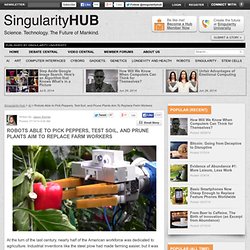
Industrial inventions like the steel plow had made farming easier, but it was still grueling labor performed by men, women, and work animals. Desert Wolf unveils riot control drone. 15 Emerging Agriculture Technologies That Will Change The World. Policy Horizons Canada worked with futurist and data visualizer Michell Zappa of Envisioning to produce a report called MetaScan 3: Emerging Technologies and accompanying infographics.
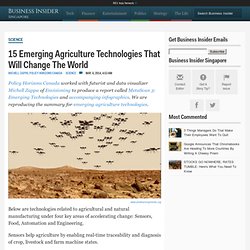
We are reproducing the summary for emerging agriculture technologies. Below are technologies related to agricultural and natural manufacturing under four key areas of accelerating change: Sensors, Food, Automation and Engineering. Sensors help agriculture by enabling real-time traceability and diagnosis of crop, livestock and farm machine states. Food may benefit directly from genetic tailoring and potentially from producing meat directly in a lab. Automation will help agriculture via large-scale robotic and microrobots to check and maintain crops at the plant level.
Engineering involves technologies that extend the reach of agriculture to new means, new places and new areas of the economy. Riot control drone that fires paintballs, pepper-spray and rubber bullets at protesters. The Skunk, a drone from South African company Desert Wolf, is billed as the first riot-control drone -- it fires dye-balls, pepper spray and rubber bullets at protesters, blinds them with strobes, broadcasts control messages to them, and records them.

Its first customers are South African mine-owners wishing to target striking workers. The Skunk is designed to control crowds without endangering the lives of security staff. 10 Robots on the Cutting Edge of Technology. In 1982, the movie Blade Runner depicted the year 2019, when life-like robots termed “replicants” walked among us undetected.

A couple of years later, a young Arnold Schwarzenegger starred in Terminator, a sci-fi flick set in the year 2029, when robots would supposedly rule the Earth. Those sci-fi dates are fast approaching, and the idea of such mobile and intelligent robots still seems 40 years in the future; the state of the art in commercial robotics is Roomba, which can vacuum a room, but is hardly ready to enslave the human race. Most futurists agree a “robot revolution” will one day come to pass … but when? Here are 10 interesting robots currently under development worldwide that show both current challenges and breakthroughs in the field of robotics. www.sciencewise-erc.org.uk/cms/assets/Uploads/Robotics-ReportFINAL02-07-2013.pdf. Autonomous Weapons Systems and the Future of War.
Military robots have been used in war in some primitive form since the beginning of the 20th century.
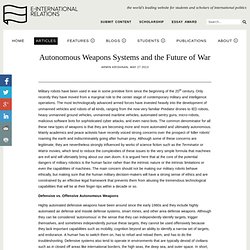
Only recently they have moved from a marginal role to the center stage of contemporary military and intelligence operations. Unmanned Insecurity: Emerging Issues of Drone Security & Information Assurance. I am pleased to announce a program on the security of drones presented by Donna A.
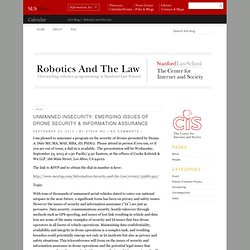
Dulo MS, MA, MAS, MBA, JD, PhD(c).